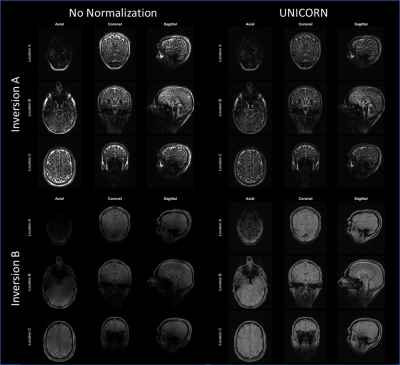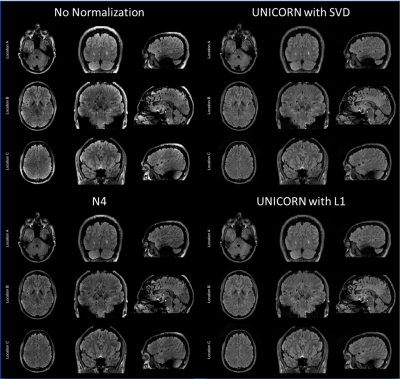Venkata Veerendranadh Chebrolu1, Xiaodong Zhong2, Patrick Liebig3, and Robin Heidemann3
1Siemens Medical Solutions USA, Inc., Rochester, MN, United States, 2Siemens Medical Solutions USA, Inc., Los Angeles, CA, United States, 3Siemens Healthcare GmbH, Erlangen, Germany
1Siemens Medical Solutions USA, Inc., Rochester, MN, United States, 2Siemens Medical Solutions USA, Inc., Los Angeles, CA, United States, 3Siemens Healthcare GmbH, Erlangen, Germany
In this work, we extend the Uniform combined reconstruction (UNICORN) algorithm to improve receive uniformity of two-, three-, or more-dimensional (N-dimensional or ND) MRI. We also demonstrate UNICORN results using L1-based optimal combination of the multi-channel data.

Figure 3: Comparison of uniformity between 7T brain MP2RAGE
MRI images with and without UNICORN (L1-based) normalization. UNICORN results for
both the inversion volumes from the 4D MP2RAGE data are shown. Images before and after normalization have
the same window-width (WW) and window-level (WL). It can be observed that
UNICORN reduced the hyper-intensity near the surface of the brain and improved
the conspicuity of the inferior regions of the brain.

Figure 2: Comparison of 7T brain dark-fluid TSE MRI
images without normalization, with UNICORN normalization, and N4 normalization. UNICORN results
from both SVD- and L1-based optimal coil combination are shown. Same window-width
(WW) and window-level (WL) were used for all the images. It can be observed
that both UNICORN options reduced the hyper-intensity
near the surface of the brain. Improved intensity and uniformity in the
interior regions of the brain (relatively better than the N4 normalization
method) can also be observed.
